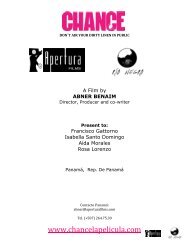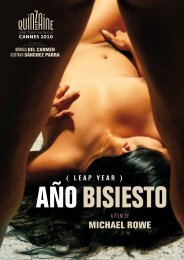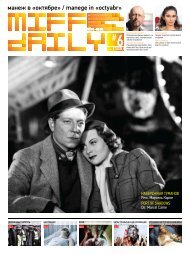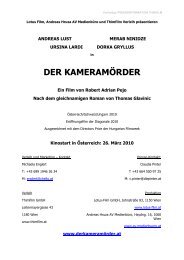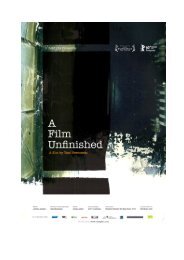Немецкое киНо. от десятилетия к десятилетию 10 DecaDes of ...
Немецкое киНо. от десятилетия к десятилетию 10 DecaDes of ...
Немецкое киНо. от десятилетия к десятилетию 10 DecaDes of ...
You also want an ePaper? Increase the reach of your titles
YUMPU automatically turns print PDFs into web optimized ePapers that Google loves.
RememberingGerman CinemaThe starting point <strong>of</strong> my interest in German cinema wasnot a film but «Guttenberg galaxy». A foreigner gave meKracauer’s English book «From Caligari to Hitler» as apresent. In it cinema was given the part <strong>of</strong> a mute oracle <strong>of</strong>history. In the dark language <strong>of</strong> expressionistic films it hadforetold everything we later witnessed. Or rather participated in, ifwe take into account the war. The book amazed me and I startedgoing to «Gosfilm<strong>of</strong>ond» to watch silent German movies <strong>of</strong> whichI knew but a few. Like many <strong>of</strong> my colleagues (Neya Zorkaya,Yuri Khanyutin) I was not a born film scholar. We switched over tocinema from theatre because in the post war years and decadesit was with the help <strong>of</strong> the language <strong>of</strong> cinema that the world wastrying to overcome its disunity. Let me remind you that at the timethe world lacked not merely the Net but decent television. Theclumsy, almost unnatural, «Caligari» was a breakthrough – intounforeseen unreality and the world <strong>of</strong> the madman which hadseemed <strong>of</strong>f-limits to the film medium. It was one <strong>of</strong> the first <strong>of</strong>its kind. Most certainly Fritz Lang’s «M» – retaliatory grimace <strong>of</strong>violence at the end <strong>of</strong> the Weimar «beautiful epoch» – condensedthe accumulated experience: the storytelling, the famous Germanplay <strong>of</strong> light and shadow, editing, acting and finally the newlyarrived sound. It was the last warning.But these two eight-reel movies are linked by a long mountainchain, posing lots <strong>of</strong> dissimilar questions.About the future –«small man –what comes next» – thefamous Kammerspiele crowned by Murnau’s «Der letzte Mann»(in the 60s it was rated next to Eisenstein’s «Potyomkin»).About the mass culture – the German cinema never shunnedpopular genres, elevating them to the level <strong>of</strong> art and winingthe masses and the box-<strong>of</strong>fice. I remember how Lyonia Kozlovand myself were mulling over Brecht’s idea, put forward in«Der Dreigroschen Prozess» that the bad taste <strong>of</strong> the public iscloser related to the actual state <strong>of</strong> things than the good taste<strong>of</strong> the intellectuals. About documentaries – «documentary»became an aesthetic category in German cinema, had certaindistinct features and designated a degree <strong>of</strong> trust while«suggestiveness» and all the different monsters – vampireNosferatu, Homunculus, Alraune atc – was a way <strong>of</strong> inculcation.Sometimes they could curiously blend, like in «Doctor Mabuse»,Fritz Lang’s most fantastic and in a way «documentary» move.Together with Naum Kleiman we tried in vain to find its Russianversion («Gilded Rot») edited by Esfir Shub and Eisenstein.About «proletarian cinema» – and in a wider sense aboutculture, creating a new degree <strong>of</strong> «documentality» («MutterKrausens Fahrt ins Glück») and <strong>of</strong>fering a new way <strong>of</strong> halfindependenthand-made production. And above all it raised thequestion <strong>of</strong> why Marxist revolutions never happened wherethere was the proletariat but where it was not in sight.About the initial «urbanism» <strong>of</strong> German cinema with itsfamous street-scapes (Karl Grune’s film is called just that «DieStraße»), with the adventures <strong>of</strong> stealing technical secretes andall possible variations <strong>of</strong> motion – streetcars, trains, planes etc.Not to mention emigration – first economic, which providedHollywood with the ravishing European shot <strong>of</strong> «Lubitsh–touch», as well as Marlene Dietrich («The Blue Angel» by vonSternberg) and later political: to American cinema it broughtnot merely the acknowledged masters like Lang but futurestars like Billy Wilder, who was making his first steps.There were lots <strong>of</strong> trends and what they all resulted un wasnot a book, as was originally planned, but a film «OrdinaryFascism», which Yura Khanyutin and myself wrote rightthere in «Gosfilm<strong>of</strong>ond» under this very titles (besides thedocumentary footage we were interested in the «little man»and monsters on the German screen).It is understandable that <strong>of</strong> all the possible question we weremost <strong>of</strong> all interested in how it could have come about that… Itconcerned not only the Germans but us as well (it is no secretto what extent Stalin promoted Hitler’s rise to power when heforbade the Komintern to cooperate with the Social Democratsat the elections). When we later took the script to MikhailRomm and faced the enormity <strong>of</strong> documentary footage werewrote it without the feature film characters.In addition to 2 million meters <strong>of</strong> footage and Kulturfilmfrom Goebbels’s archive, which was at the time stored in«Gosfilm<strong>of</strong>ond». Khanyutin and I had a chance to see someNazi feature films, which were kept there marked «secret».In reality some <strong>of</strong> them – mostly adventure and costume ones– were already known to Soviet viewers. They were screenedas «trophy films» under different titles and had no cast listing.This was a unique phenomenon <strong>of</strong> Soviet reality which broughtthe state a very sumptuous income. Most notable among themwas the super-phenomenon «Die Frau meiner Traume» withMarika Rökk. For the generation <strong>of</strong> victors it became a realdream and almost a cult movie. The memories <strong>of</strong> this amazingstellar flash faded away together with this generation.Most certainly Veit Harlan’s «Jud Süß» was at the forefront <strong>of</strong>Nazi anti-Semitic propaganda and in this sense reflected theodious German spirit.But the carefully guarded «secret» which was revealed whenwe watched these movies, was that there was an amazingsimilarity between the Nazi and the Soviet films. To tell thetruth, it came as a shock. It was then that we got the idea <strong>of</strong> acomparative retrospective which at the time could be only ourprivate secret.Between 1964 and 1989, when I finally managed to hold theretrospective «Films <strong>of</strong> the Totalitarian Epoch» at the Moscowfilm festival with the help <strong>of</strong> Kirill Razlogov, Katia Khokholovaand Artyom Demenok, half a century elapsed. Both Yura andRomm were gone.Nazi movies were for the most part entertaining. Incidentally,a similar project existed in Soviet cinema, but it couldnot break through the barrier <strong>of</strong> «vigilant» or rather timidbureaucrats.German cinema had been monopolized by the state by1944 and it is hard to say what the results could havebeen. But both cinemas were based on the same cinematic«vertical» – leader – hero – young victim – traitor – enemy,which constructed movies as national mythology. The mostinteresting component is the young victim, which legitimizesthe ideology as a sort <strong>of</strong> quasi-religion («Road to Life» –«Hitlerjunge Quex: Ein Film vom Opfergeist der deutschenJugend»)The retrospective came too early not merely for the still Sovietsociety, but for the European left-wing as well. I rememberErwin Leisner, the author <strong>of</strong> the documentary «Mein Kampf»stopping me and saying: «Maya, how could you?» and asked:«Erwin, why are you not watching?» Later we showedthe abridged version <strong>of</strong> the retrospective at the exhibition«Moscow-Berlin» in Germany. Most <strong>of</strong> all I regret that it failedto come up with somethingLike a video square route for today’s discussion.A propos, when I later worked at a similar Soviet-Americanretrospective in the USA, I realized that the amount <strong>of</strong>differences and similarities is not a result <strong>of</strong> ideologicalmaxims alone, it can be seemingly arbitrary, determined bythe epoch. I could not explain it in any other way besides «thespirit <strong>of</strong> the time».It is a pity that «Die Mörder sind unter uns » (the title wasborowexd by Staudte from Lang’s pre-war opus which wasrenamed and became «Das Testament des Dr. Mabuse») didnot make its way into the present retrospective. It was the firstpost war film. As yet it was neither East German, nor WestGerman, although its production was supervised by Soviet«<strong>of</strong>ficers <strong>of</strong> culture». To German cinema it restored selfrespectand the link to expressionism. And finally it discoveredthe new diva Hildegard Knef.Subsequently German cinema went two different ways andI had contact both with its West German and East Germanvariation, abroad and in Moscow.The early «Der geteilte Himmel» by Konrad Wolf, based onthe novel by his namesake Christa Wolf, is an early example<strong>of</strong> serious filmmaking in the GDR. At the same time the filmuses the lessons <strong>of</strong> expressionism in its own way. Koni Wolfwho was my schoolmate at the Moscow school 1<strong>10</strong> and latera VGIK student, a crown prince <strong>of</strong> German cinema and futurePresident <strong>of</strong> the Academy <strong>of</strong> Arts <strong>of</strong> the GDR, could afford alot. But surprisingly, in spite <strong>of</strong> all his regalia, he permittedhimself to be honest and doubting. Not that he ever doubtedsocialism, the faith in which he inherited from his father andGerman proletkult, but in the actual society and in his ownplace <strong>of</strong> the artist in particular. I remember he brought toMoscow a «dull» but deep and even scathing film «Der nackteMann auf dem Sportplatz». Dinner was served at the Writers’House and he hoped for a discussion <strong>of</strong> this very importanttheme… But only Ira Rubanova and myself came.In essence he was very lonely between the two cultures, theRussian and the German. Once, working with Koni at his movieabout Ernst Busch, I asked him to compose a short forwardto the script <strong>of</strong> «Ordinary Fascism». «In what language? - thepresident asked. – In Russian or in German?» – «Koni! Thescript is in German!» – «I’ll tell you, Maika, in private (we wereon friendly terms since the school years) I write my academicspeeches in Russian and then translate them into German».Soon Koni died – horribly and suddenly. His wife at the timetold me that before his death in Charité he raved in Russian.And nobody understood him. I was not allowed to attend hisfuneral for lack <strong>of</strong> the necessary status.12 13



